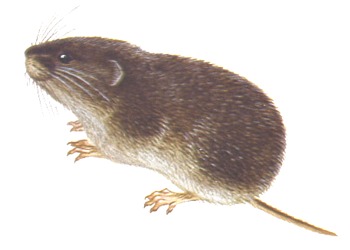Pests
Microtus (Alexandromys) fortis Buchner. - Reed Vole or Far-Eastern Vole.
Systematic position.
Class Mammalia, order Rodentia, family Cricetidae, subfamily Microtinae, genus Microtus, subgenus Alexandromys (Ognev, 1914)-far-eastern voles. The species includes 6 or 7 poorly investigated modern subspecies.Biological group.
Rodent pests.Morphology and biology.
The biggest species of the genus Microtus. Body length is up to 176 mm, tail length is up to 75 mm (1/3 to 1/2 of body length, about 38% on average). Back is dark, gray-brown. Tail is sharply bicolored, black from above, whitish from below. Diploid chromosome set is 52. Inhabits forest and forest-steppe zones, including flood plains and boggy plots, banks of rivers and lakes, agricultural lands; in mountains the vole is found up to 2000 m above sea level.Distribution.
Within the Russian Federation the species occurs in Transbaikalia, Vitim Plateau (northward to mouth of the river Selenga and to the cities Chita and Nerchensk), Amur Region, Khabarovsk Territory, Primorskii Territory (northward to 54°N). Beyond the Russian Federation inhabits north-eastern Mongolia, northern and eastern China, and Korean peninsula (southward to 20°N).Ecology.
Reed Vole habitats are closely connected to fresh water basins. It swims and dives well. It has round-the-clock activity, in summer it is mostly nocturnal. Lifestyle is family-colonial; all the burrows of one colony are connected to each other by a net of surface runways gnawed away in herbage. In dry places the burrows have complicated construction, with large number (to 20) of exits, subterranean passages, nesting chamber and food storage chamber. In wet and boggy places and near water basins the burrows are more simply constructed, having globular nests built of grass and situated on the surface, in tussocks or other flood-free places. Like other voles, the Reed Vole is strictly vegetarian. The content of food is diverse, changing according to season and habitat. The Reed Vole stores food for winter. Reproductive potential is rather high. In different parts of the area over-wintered female reed voles give 3 (Transbaikalia) to 6 (Primorskii Territory) litters. Average number of young voles in every litter is 6 to 8. Young animals begin to breed at the age of 45 to 50 days, and they give 1 or 2 litters by the end of an agricultural season. Population size is subject to considerable seasonal and multi-year fluctuations. In some years there are rises in population size and mass outbreaks. They mainly happen due to favorable weather conditions, i.e., snowy winter, warm and early spring, summer with moderate rainfalls, long, warm and dry autumn.Economic significance.
The Reed Vole is a main pest of agricultural crops in Primorskii Territory. It damages grain and legume crops, potato tubers, different edible roots, etc. In winter it causes harm in gardens and arboretums, gnawing away bark of trees and seedlings. The Reed Vole plays a rather important role in spreading very dangerous human and domestic animal infectious diseases, including tick-born encephalitis, rickettsias, Japanese river fever, salmonellosis. Control measures include timely and high-quality (without losses) harvest, maintenance of crop rotations, deep plowing, and baiting with rodenticides.Reference citations.
Gromov I.M., Erbaeva M.A. 1995. Mammalia in fauna of Russia and adjacent territories. In: Aristov A.A., Baranova G.I., editors. Duplicidentata and Rodentia. Saint-Petersburg: ZIN RAN. 552 p. (In Russian)Gromov I.M., Polyakov I.Ya. 1977. Voles (Microtinae). In: Strelkov A.A., editor. Series Fauna of the USSR. Mammals. Leningrad: Nauka. V. 3(8): 504. (In Russian)
Kolosov A.M. 1980. Zoogegraphy of the Far East. Moscow: Mysl. 254 p. (In Russian)
Kostenko V.A., Nesterenko V.A. 1989. Rodents of cultivated lands in Primorskii Territory. Tiunov M.P., editor. Vladivostok: DVO AN SSSR. 64 p. (In Russian)
Sokolov I.I., ed. 1963. Mammals in fauna of the USSR. Part I. Leningrad: AN SSSR. 638 p. (In Russian)


